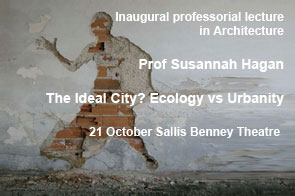Susannah Hagan, Professor of Urban Studies
Will present her lecture entitled: The Ideal City? Ecology vs Urbanity
Thursday October 21 2010 6.30pm
Historically, architects have engaged in critiques of the urban status quo through the production of idealised images of new kinds of city. This tradition continued right into the late 20th century, through Modernism and post Modernism, but has now come to a halt in the face of the requirements and expectations surrounding sustainable development. For an undertaking to be sustainable it must achieve economic viability, social justice and environmental friendliness. A very tall order, an ideal condition, to which one can only aspire.
We have two models for urban sustainability, contained, so far, more in texts than drawings. The compelling imagery that has traditionally accompanied the call for change is for the most part missing in this call to live more cooperatively with the biosphere, perhaps because not enough architects understand what that entails. The dominant ‘Compact City’ model for urban sustainability fights petrol-consuming sprawl, and the ‘hairy’ city model drapes every available surface in greenery, allows natural systems like rivers and flood plains to function, and needs space, rather than compaction.
Common to both is the foregrounding of the city's metabolic processes – resources in/wastes out –the efficiency or inefficiency of which affects cities, their coffers, and their citizens. To reorganise an urban metabolism and work with natural systems requires the specialist knowledge of environmental engineering, and this has still to develop a working relationship with conventional urban design. A city isn’t only a metabolism, after all. That would be like saying the physical churnings of the human body are the sum total of a human being. Nevertheless, this new environmental practice does have the potential, not only to sit happily with the practice of urban design, but to actively help in making, in Le Corbusier's words, 'The City of Tomorrow', or rather, to radically reconfigure the cities of today.
Susannah Hagan joined Brighton from the University of East London, where she was Reader in Architecture, and founder and programme leader of the MA Architecture: Sustainability + Design. She is Director of R/E/D (Research into Environment+Design), a London-based research consultancy with a European membership that focuses on research by design, specifically environmentally-led design at both urban and architectural scales. She studied architecture at Columbia University, New York and the Architectural Association, London, is a Fellow of the Royal Society of Arts and of the Forum for Urban Design, New York, and a member of the International Development Network, Royal Town Planning Institute and the London Borough of Newham Design Review Panel. Written work includes the books Taking Shape: the new contract between architecture and nature (Architectural Press, 2001), City Fights with Mark Hewitt, (James & James (Science) Publishers, 2001), and Digitalia: architecture and the environmental, the digital and the avant-garde (Taylor & Francis 2008), and articles ranging from the Harvard Design Magazine to the Arkitekturmuseet Journal, Stockholm.
Light refreshments will be served after the lecture.
Please RSVP to events@brighton.ac.uk
